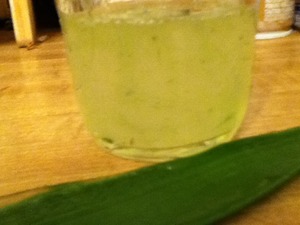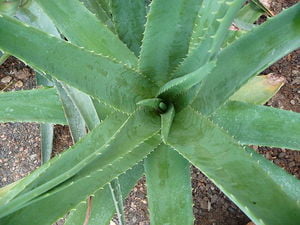Most of us know that aloe vera gel is great for soothing sunburns, and skin irritation in general. Many of us stock up as summer approaches and as winter wind chaps cheeks and lips. The gel is also an ingredient in many products made for skin, nail, and hair care. I have bought and used it so many times, and mixed it into so many recipes, and never thought I could harvest my own. Sure, I know I always knew I could break a piece off of my aloe plant and apply it’s contents to my skin. However, I would not want to do that in large quantities in fear of stunting the growth of my plant. Finally; after gathering my courage, doing my research, and much trial and error, I worked out a method of extracting and storing pure aloe vera gel for my personal and professional use.
To get started growing and harvesting aloe, you need some basic background so that you can get the best results. First off, the aloe vera plant is part of the lily family despite its leaves which resemble plants in the cactus family. Each of those leaves that so resemble succulents, is full of a thick liquid, only some of which is good for harvesting and using. That precious gel has been treasured for its healing properties for thousands of years.
Each of the aloe leaves is made up of four distinct layers. The outside, the hard green protective layer, is called the rind. The next layer consists of a bitter liquid. This liquid lies directly under the rind, and is the sap. The sap is bitter, and the combination of the tough rind and bitter tasting sap protects the aloe vera plant from being eaten. After the sap there is a mucilage gel, which surrounds the most useful portion of the plant. However, if the final use of the gel you harvest is for external use only, you can use the inner leaf’s mucilage gel along with the center part of the leaf.
The center part, and most valued, has many names. It is called the inner gel, gel filet, or aloe vera. This precious gel holds eight of the amino acids our bodies need but cannot make. This inner gel can be taken internally, but this is the only portion of the plant that is safe for consumption. I do not recommend consuming any of the gel you harvest yourself, I do not ingest any I have harvested, because it is very easy to contaminate the innermost gel with the mucilage layer. Be sure that when harvesting to avoid collecting any of the sap since that portion of the pant is not useful topically or internally.
Now, on to how to actually harvest the gel. Instead of wasting precious gel by simply breaking off a portion of a aloe leaf and squeezing the gel onto your skin, the most efficient way to collect that gel is to filet the leaf. This process allows you to gather the most of the gel, limit the contamination from the other layers, and cause the least waste. Choosing the right leaf is as important as doing the work right. Select an outer leaf that looks healthy and is growing towards the base of the plant. If your plant does not have any leaves growing close to the ground then it is best to wait a little longer before harvesting. Now you are fully equipped to harvest some of your own aloe vera gel. The only things you need is the desire, an aloe plant ready to be harvested, a sharp knife, a spoon or butter knife, a cutting board, and the willingness to give it a try.
Directions:
1. To remove the chosen leaf from the plant, cut it at an angle as close to the plant’s base as possible. 2. Place the cut leaf upright in a container. It is best to place it at a slight angle to allow the sap to drain away. This should take ten to twelve minutes. I sometimes leave the leaf in that position for up to twenty minutes to make sure the sap has really drained away, however if you leave it alone too long the wound will seal up. Sometimes sap will still remain, hiding in crevices, so be careful of contamination in latter steps.
3. Lay the aloe leaf on a cutting board. Using a sharp knife, carefully trim off the very tip of the leaf and the pointed rough edges of each side.
4. Use the knife to slice the leaf lengthwise through the cuts you have already made on each side.
5. Use a spoon, or a butter knife if working on a very large leaf, to scoop the mucilage and inner gel from the leaf. press down firmly but lightly with your utensil to get all of the gel. However, be careful not to retrieve any of the sap that might remain in the leaf. You can do this on the cutting board or in a bowl with a large bottom. using a bowl might make it easier to transfer the harvested gel into a jar. sliding the gel from a cutting board into a container can be a tricky and frustrating process.
6. When possible, use a dark glass container if you plan on long term storage. However, a clear plastic or glass container will certainly work. I generally just use a mason or jelly jar.
A few hints for your information. A little citric acid, vitamin E, grapefruit seed essential oil, or a crushed vitamin C tablet can help keep your gel from discoloring and help it last longer. This is rarely a concern for me, since I use the gel regularly in my bath and body products, but it is a good thing to know. Even without the help, your aloe vera gel can last for up to a year in the refrigerator, cool and ready for use.




